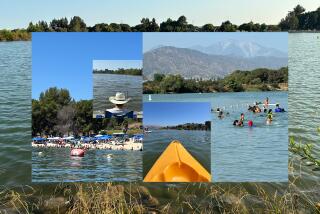Ready for Freddy : Fish Are Named Under the Ice at Mammoth Lakes, and Snowmobiles Are the Best Way to Get at Them
- Share via
MAMMOTH LAKES — Snowmobiles whine across their roof, and gasoline-powered ice augers drill eight-inch holes that let in the light, but Len and Louie and Freddy Mo’Ready are oblivious to the commotion above.
It will only last two or three more weeks, anyway, and then life on Lake Mary will return to normal for the little lake’s biggest fish. There is only a small window of opportunity for ice fishing by snowmobile in the Mammoth Lakes basin, between the opening of trout season on the last Saturday in April and the spring thaw at 9,000 feet.
In some years ice fishing has lasted well into June, but this year the ice is expected to be gone by the end of May. It is only five to six feet thick because of the blanket of the lake’s second-heaviest snowfall in history--plenty thick to hold a snowmobile, but not enough to long withstand sunny days in the 50s and 60s, the way it was last weekend.
The road from town should be plowed about the time the lakes thaw, and by the Fourth of July, even the skiers will have to abandon the manicured slopes on the other side of Mammoth Mountain. Until then, the snowplows on Old Mammoth Road stop where the cabins end, so the choices for proceeding farther are to hike, ski cross-country--uphill--or use a snowmobile. In these parts you don’t wait for the next season. You enjoy the one you have.
Snowmobiles are as easy to run as a vacuum cleaner. Bob Hudson of Center Street Rentals, one of three rental companies in town, gives an orientation that takes about five seconds: start switch, pull-cord, throttle, brake.
Mammoth Lakes and the U.S. Forest Service have produced a winter recreation map showing 250 miles of snowmobile trails, including many on the east side of U.S. 395, reached through a tunnel under the highway. The lakes basin is closed to snowmobiles until after Easter, and designated wilderness is closed to mechanized transportation all the time. But snowmobiles sometimes go as far as Bodie, the ghost town well off the main road southeast of Bridgeport.
The downside of a snowmobile is the noise. You won’t sneak up on any wildlife. It also offers fair warning to cross-country skiers, who offer wary glances and seem more than willing to surrender the right-of-way. The idea is to stay between the trees, which go past at an alarming rate, even on a stretch of road where a road sign half-buried in snow says, “SPEED LIMIT 30.”
*
If you just want to fish, it’s an easy 3 1/2-mile ride to Lake Mary, where you drive onto the lake and pull to a stop alongside a hole: drive-up fishing.
Mammoth’s five basin lakes--Mary, Mamie, George and the Twins--aren’t planted until the ice clears, but then they receive weekly supplies of trout from the state and Tim Alpers’ private hatchery nearby. The town spends $20,000 a year for 3,000 of Alpers’ fish that weigh from two to eight pounds. Most of those that aren’t caught during the summer are still there in the spring.
The smarter anglers drill their holes where they would fish if the lake weren’t frozen: near the creeks that feed or drain the lake, even in winter. Ice fishing is only slightly more complicated than driving a snowmobile. Rick Young, a guide at Barrett’s Landing on the lake, explains his techniques.
“The sinker’s on the bottom, a little different from (using) a sliding sinker on top,” he says. “The weight will hit the weeds at the bottom before the hook will, so you can tell where the bottom is without getting your hook caught in the weeds.”
Young ties on separate leaders above the weight.
“We have a worm hook and then a treble hook for cheese bait or salmon eggs,” he says. “When you’re using a bait rig, you don’t jig up and down. You find the bottom and bring it up two or three feet.”
Young rigs a small crappie-type jig on another rod.
“We’ll jig this up and down--slowly sometimes, sometimes quicker--and we’ll put a worm on the end, which will simulate a little guts coming out to attract (the fish) a little better. Get your feel where the bottom is and just bounce.
“If you’re using a jig they’ll get right on it. If you’re using bait, let them nibble a little before you set the hook. You’re going to feel them bite pretty good. Just give it a good, firm set--but not too hard.”
*
Don and Betty Joy Barrett own the Barrett’s Landing tackle and grocery store. His mother, Louise, owns the Pokonobe Lodge at the other end of the lake. They are the third family to own property around the lake from a deed of about 500 acres issued by President Ulysses S. Grant in the 19th Century--one of the first “Grant” deeds, Barrett points out.
Barrett tried to research the titles but was told that the original deed was lost in a stagecoach robbery between Bridgeport and Virginia City. So all he’s sure of is the fishing.
“When you catch your larger fish, you’ll catch them almost always four or five feet off the bottom,” he said. “Freddy Mo’Ready always stays about five feet off the bottom.”
Freddy is a German brown trout and part of the lore of Lake Mary.
“You can see him with a depth finder anytime and within 50 or 100 feet of his territory,” Barrett said.
Len and Louie are large and inseparable rainbows. The state records for browns and rainbows are 26 pounds 8 ounces and 27-4, respectively. Barrett swears Freddy, Len and Louie are larger.
In fact, Barrett claims the undocumented lake record for a rainbow is 28 3/4 pounds, caught about 45 years ago, and that he saw a 27-1 rainbow caught from shore in 1965.
Barrett tells of encounters with Freddy.
“Three years ago some guys were trolling large flies late in the evening when all of a sudden one of the guy’s poles bent over and everything just stopped,” he says. “They thought they’d snagged the bottom. They put the boat in reverse and tried to go back to it, but as they did they found out it was moving.”
According to the story, Freddy pulled the boat around the lake until the line snapped.
“At first we were all saying, ‘Yeah, OK,’ ” Barrett says. “Two weeks later I was taking a whole family out at 4 in the afternoon, way too early for trolling flies in the evening. We got down to where Freddy lives, and all of a sudden the woman’s pole went boom!-- all the way down. She had 20-pound test line on it. I thought, ‘well, we’ve snagged up.’ So I put it in neutral and started to go into reverse when the pole just went straight down stiff.
“I thought, ‘What in the world! This could be a very large fish.’ So I said, ‘Just reel,’ and she reeled. The lady says, ‘I’m very tired.’ Her husband told her, ‘No, honey, you just keep cranking. I think you have a fish.’
“We got it to within 100 feet--a very large fish. I’d never seen anything like it. All of a sudden, here came two of the local kids from town in a runabout, hauling down the lake full speed--which they’re not allowed to do. . . .”
The kids’ boat roared across the line, severing it. So, Barrett says, Freddy is still there.
“Browns are very territorial,” Barrett says. “I know exactly where he lives.”
When the lake isn’t frozen he can prove it with an electronic fish-finder. Freddy probably isn’t much interested in eating until the water warms up.
But Len and Louie could be ready to play. They aren’t particularly difficult to hook--just to catch.
“They like lures, and whenever somebody hooks them they break it off,” Barrett says. “Len and Louie sell a lot of lures for me.”
That’s why klutzy anglers love ice fishing. Casting ability is of absolutely no importance. All that matters is to keep the line near the center of the hole and at the proper depth. Some prop up the rod in the snow or on a stick, attach a bell and leave it alone.
Some even go off to ride their snowmobiles at freeway speeds across the frozen lake while waiting for the fish to bite. They may return to find their bells ringing and rod tips jumping. Ice fishing doesn’t have to be boring.
A 4 1/2-pound brown was caught at Lake Mary on opening day--pulled right up through a hole in the ice.
“You have a chance to hook Len or Louie,” Barrett says. “I don’t think you’ll get them up through the hole, though. Their girths are bigger than eight inches.”
More to Read
Sign up for The Wild
We’ll help you find the best places to hike, bike and run, as well as the perfect silent spots for meditation and yoga.
You may occasionally receive promotional content from the Los Angeles Times.






